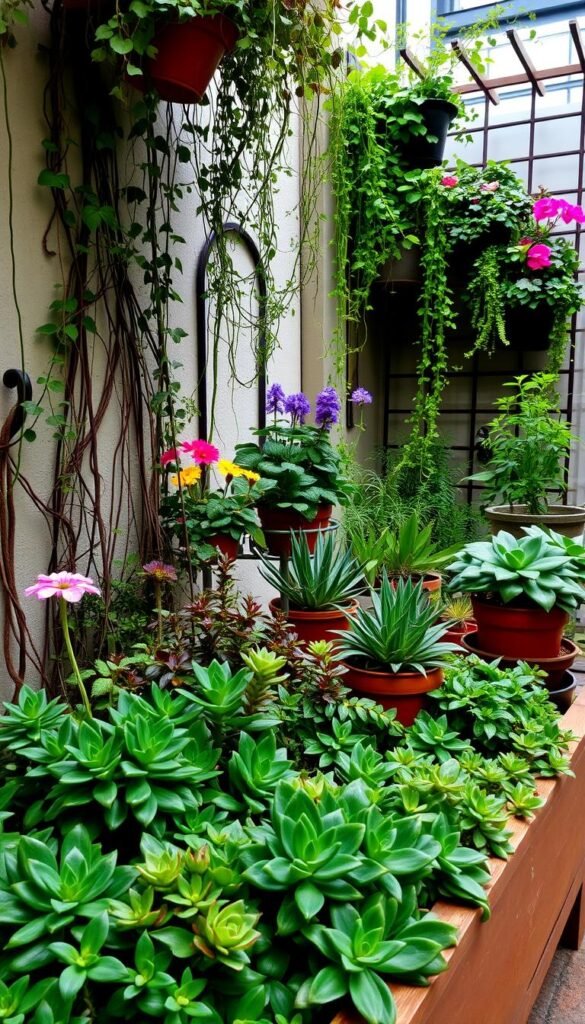Think your modest patio or balcony can’t become a lush paradise? Think again. Even the coziest corners can bloom into vibrant escapes with smart planning. This guide reveals how to maximize every inch of your outdoor area using professional landscaping techniques.
You’ll learn to select plants that thrive in confined conditions while creating visual depth. Discover vertical growing solutions that add layers without clutter. We’ll explore container arrangements that bring color and texture to railings, walls, and floors.
Small areas demand clever choices. Focus on multi-functional furniture and strategic lighting to extend usability into evening hours. Use mirrors and reflective surfaces to double the perceived space instantly. These tricks help craft an inviting atmosphere that feels spacious yet intimate.
Your personal oasis awaits – no sprawling yard required. Through intentional design and plant selection, even postage-stamp patios become cherished extensions of your living space. Let’s transform how you experience outdoor living, one smart solution at a time.
Understanding Small Garden Design

Don’t underestimate the power of thoughtful layout in transforming cramped areas into charming escapes. Smart planning helps you work with your square footage rather than against it, turning limitations into creative opportunities.
Why Smaller Works Better
Compact outdoor zones require less upkeep than sprawling lawns. You’ll spend fewer hours weeding and more time enjoying your sanctuary. Water bills stay manageable since container plants and raised beds need targeted hydration.
These intimate settings naturally foster relaxation. Picture yourself surrounded by greenery without feeling overwhelmed – every element exists to serve your comfort.
Rules for Spatial Harmony
Aim for equal parts hardscape and greenery. This 50/50 balance prevents visual chaos while allowing room to move. Multi-use features like ottomans with hidden storage or fold-down tables keep surfaces clear.
Guide the eye using repeating shapes or colors. Three matching pots along a wall create rhythm. A bold sculpture or fountain becomes an instant focal point, distracting from the area’s size.
Vertical layers add depth without clutter. Wall-mounted herb gardens or tiered plant stands draw attention upward, making ceilings feel higher and boundaries less constricting.
Planning for Your Small Outdoor Space
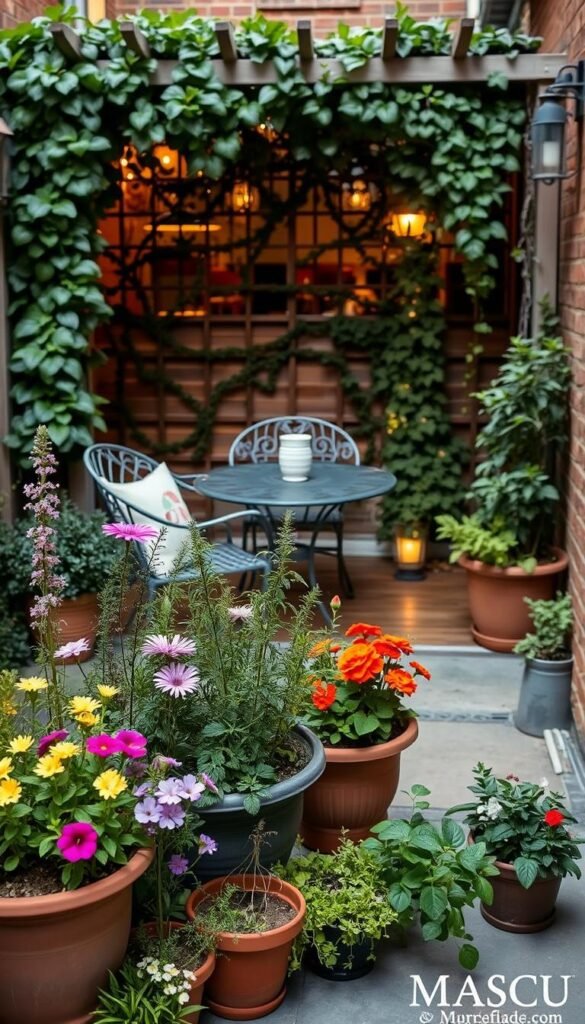
Your compact outdoor area holds potential—unlock it through strategic design. Begin by measuring every dimension and sketching permanent features like fences or utility lines. This blueprint becomes your roadmap, helping avoid costly mistakes later.
Seek inspiration beyond your backyard. Visit botanical gardens or scroll through social media feeds to spot trends that fit your vision. Flower shows often showcase space-saving solutions you can adapt, like foldable furniture or modular planters.
Budget-friendly choices make big differences. Gravel costs 60% less than concrete paving while offering better drainage for plant roots. Compare materials using this guide:
| Feature | Paving | Gravel |
|---|---|---|
| Cost per sq.ft | $8-$15 | $1-$3 |
| Installation | Professional needed | DIY-friendly |
| Plant flexibility | Limited | High |
Define your space’s primary role early. Will you host barbecues or grow herbs? Track sunlight patterns for three days—note where shadows fall at noon. This determines whether roses or ferns will thrive in specific spots.
Remember: Great designs balance beauty and practicality. Your outdoor oasis should reflect both your needs and personality.
Choosing the Right Plants and Focal Points
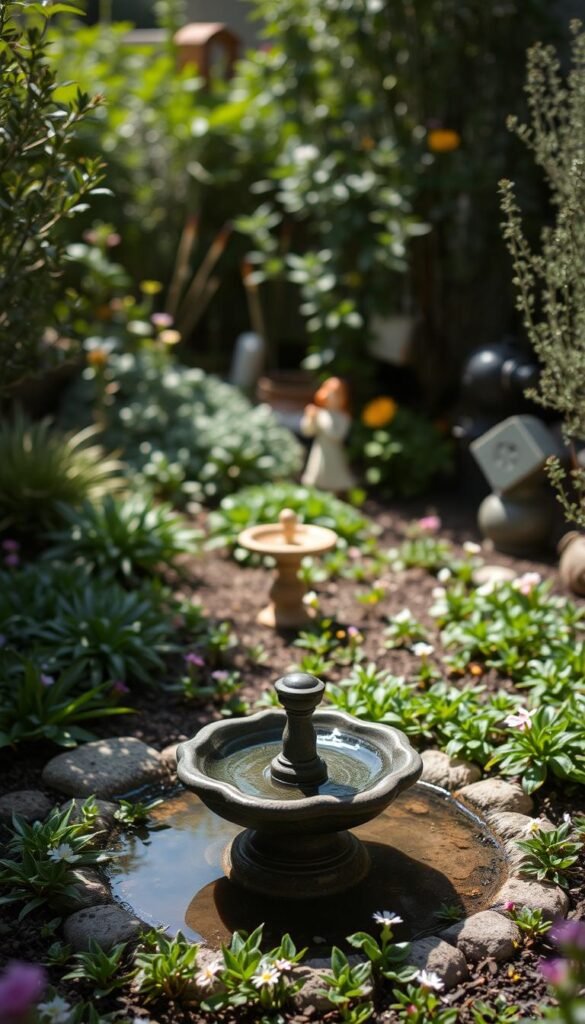
Even the tiniest garden can shine with strategic greenery and intentional accents. The secret lies in pairing space-conscious plants with eye-catching elements that command attention without overwhelming your area.
Selecting Compact Varieties
Start with long-blooming stars like Rosa ‘Flower Carpet Amber’ – this powerhouse delivers color for eight months. Pair it with low-maintenance options like Erigeron karvinskianus, whose daisy-like flowers self-seed in cracks and crevices. These varieties thrive in confined spaces while delivering maximum visual impact.
Consider vertical growers to save floor space. Alliums stretch toward the sky with purple globes, while dwarf fruit trees trained against walls offer edible beauty. Remember: “Small-space gardening rewards those who think upward, not outward” – a principle that helps avoid common mistakes in small-space gardening.
Creating Natural Focal Points
Choose one standout feature to anchor your design. A cobalt-blue pot overflowing with agapanthus draws immediate attention. Odd-numbered groupings work best – three ornamental grasses in matching planters create rhythm without clutter.
Use texture contrasts to enhance your focal point. Pair spiky yucca plants with soft lamb’s ear foliage near seating areas. This approach adds depth while keeping the space feeling intentional and curated.
Maximizing Vertical Space in Tiny Gardens
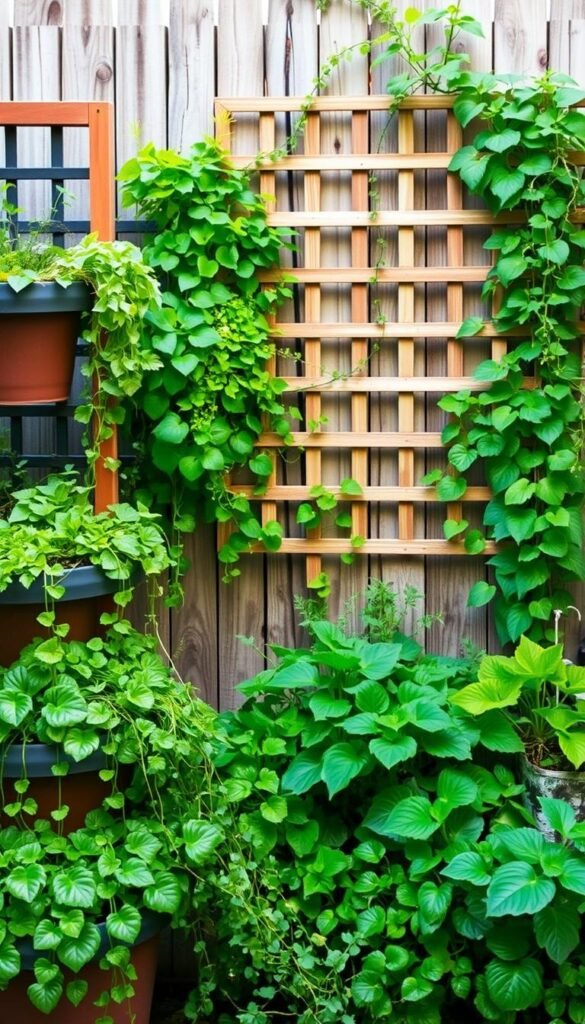
Reach new heights by transforming unused vertical surfaces into lush displays. This approach lets you grow more plants while keeping walkways clear. Perfect for patios, balconies, or narrow side yards.
Hanging Baskets and Vertical Planters
Turn blank walls into blooming masterpieces with suspended containers. Hanging planters work wonders for trailing varieties like million bells and ivy geraniums. Mount them at different levels to create depth.
Try stacking pocket systems for herbs or strawberries. These space-saving solutions let you harvest fresh ingredients without bending over. Pair with wall-mounted troughs for cascading ferns or succulents.
Installing Green Walls and Trellises
Transform fences into living art with modular vertical garden solutions. Many kits include self-watering features – ideal for busy gardeners. Train jasmine or climbing roses on trellises for fragrant privacy screens.
Add height with slender structures like obelisks. Grow edible climbers such as pole beans or nasturtiums. Their upward growth pattern maximizes yield in tight quarters.
| Vertical System | Best For | Cost Range |
|---|---|---|
| Pocket Planters | Herbs & Flowers | $20-$50 |
| Modular Green Wall | Leafy Greens | $80-$200 |
| Freestanding Trellis | Climbing Veggies | $40-$120 |
Mix textures for visual interest. Combine feathery asparagus fern with bold elephant ears in your vertical arrangements. This layering trick makes small areas feel richly designed.
Establishing a Cohesive Color Palette
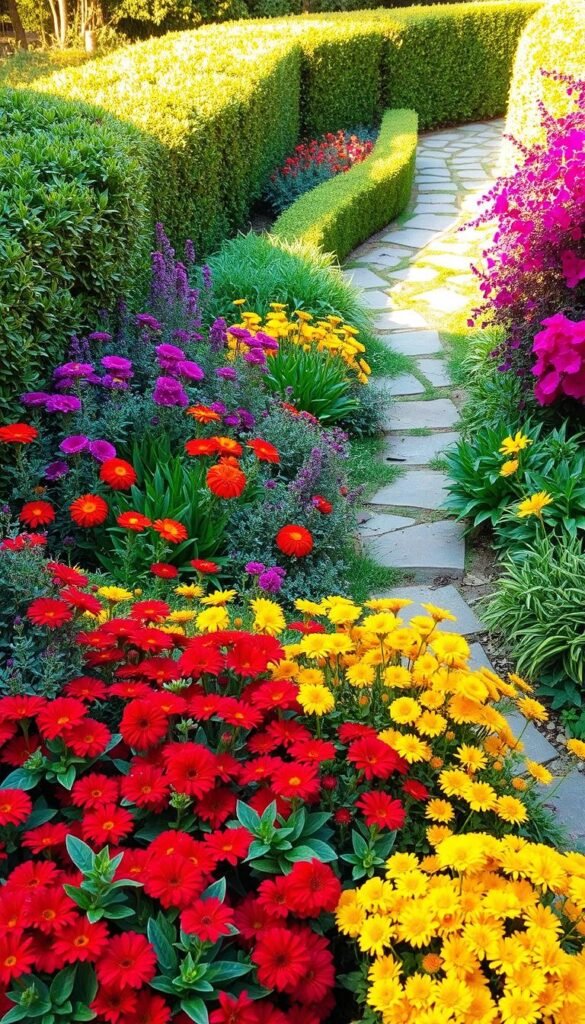
Your outdoor area’s visual impact starts with smart color choices. Cool-toned plants like lavender and hydrangeas create depth, making walls appear farther away. This optical trick helps even narrow spaces feel airy and expansive.
Bright reds and oranges demand attention, crowding your sightlines. Instead, build around blues, purples, and silvery greens that whisper rather than shout. Professional designers often follow the “three-color rule” for tight spaces – one dominant hue, two accents, and neutral textures.
Repeat your chosen shades through foliage, containers, and decor. A cluster of blue ceramic pots echoes delphinium blooms across the patio. Variegated hosta leaves mirror gray stone pavers. These intentional echoes guide the eye smoothly through your layout.
Pro tip: Add warmth through wood tones instead of fiery flowers. A cedar bench or teak planter box introduces richness without shrinking your space. As landscape architect Julie Moir Messervy notes: “Color harmony isn’t about matching – it’s about creating conversations between elements.”
Stick to your palette when adding seasonal accents. White pumpkins in fall and blue glass ornaments in winter maintain year-round cohesion. Your space stays polished, never chaotic.
10 Tiny Garden Ideas that Deliver Big Impact in Compact Spaces
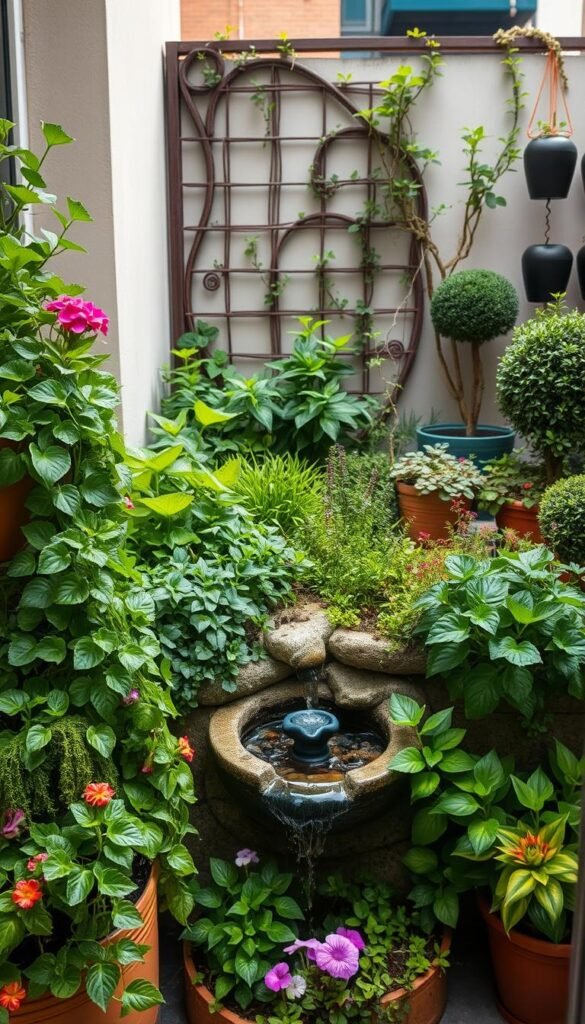
What if your outdoor area could double as a creative canvas? These clever hacks prove even the smallest spots can burst with personality. Let’s explore five transformative approaches that redefine what’s possible in confined settings.
Space-Enhancing Design Strategies
Revive old tools as plant showcases. A weathered wheelbarrow becomes a mobile flowerbed – tilt it slightly for drainage and fill with drought-tolerant sedums. Portable displays let you chase sunlight or create seasonal focal points.
Turn structural elements into plant galleries. Mount colorful pots on fence posts using sturdy brackets. This vertical approach adds height while keeping walkways clear. Try mixing trailing ivy with upright lavender for textural contrast.
Guide movement with purpose. Decorative stepping stones create intentional pathways through your green oasis. Choose materials that complement your style – etched concrete for modern spaces or irregular slate for rustic charm.
Vertical growing systems maximize every inch. Hang pocket planters on sunny walls for herbs like basil and thyme. Freestanding trellises support climbing veggies while acting as living room dividers in tight backyards.
Repurpose household items for quirky charm. Colanders make excellent hanging planters – their perforations provide natural drainage for succulents or strawberries. “The best designs often come from unexpected sources,” says urban gardener Marco Bianchi.
These inventive approaches show how limitations spark creativity. Your compact area becomes a testament to smart design, blending function with playful expression.
Incorporating Functional Elements: Seating and Storage
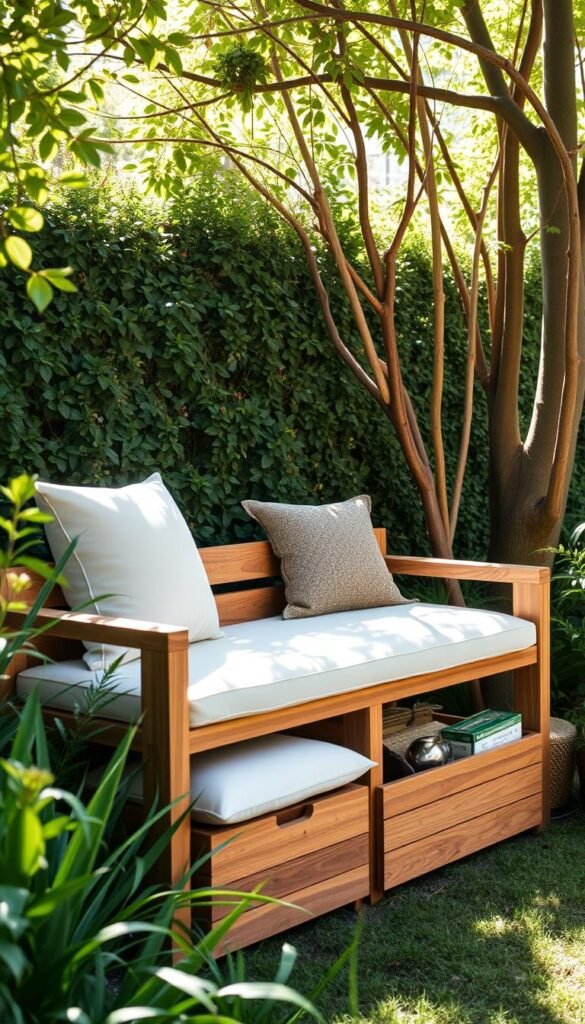
Your cozy outdoor nook becomes twice as useful when seating pulls extra duty. Dual-purpose furniture transforms cramped corners into inviting retreats while solving storage puzzles. Let’s explore how to blend comfort with clever organization.
Hidden Treasures Under Every Seat
Storage benches serve as social hubs and secret stashes. Choose weather-resistant models with lift-up lids to tuck away tools or cushions. Place one against a fence to create instant seating that hides holiday lights or spare pots.
Corner units maximize awkward angles. An L-shaped bench with built-in cubbies eliminates the need for a central table – perfect for narrow patios. Top with outdoor pillows that match your garden aesthetic for cohesive style.
Built-in solutions offer permanent charm. Masonry benches with hollow bases provide rodent-proof storage for bulk soil or seasonal decor. “The best small-space designs make every element earn its keep,” notes landscape designer Elena Carter.
Consider these space-saving stars:
- Ottomans with waterproof interiors for toy storage
- Planter boxes with wide ledges for impromptu seating
- Modular sectional pieces that rearrange as needed
Your space stays tidy when essentials live where you use them. Keep kneeling pads near vegetable beds, or stash twinkle lights under the bench where you’ll string them up. Smart storage means more time relaxing, less time searching.
Utilizing Containers and Raised Beds
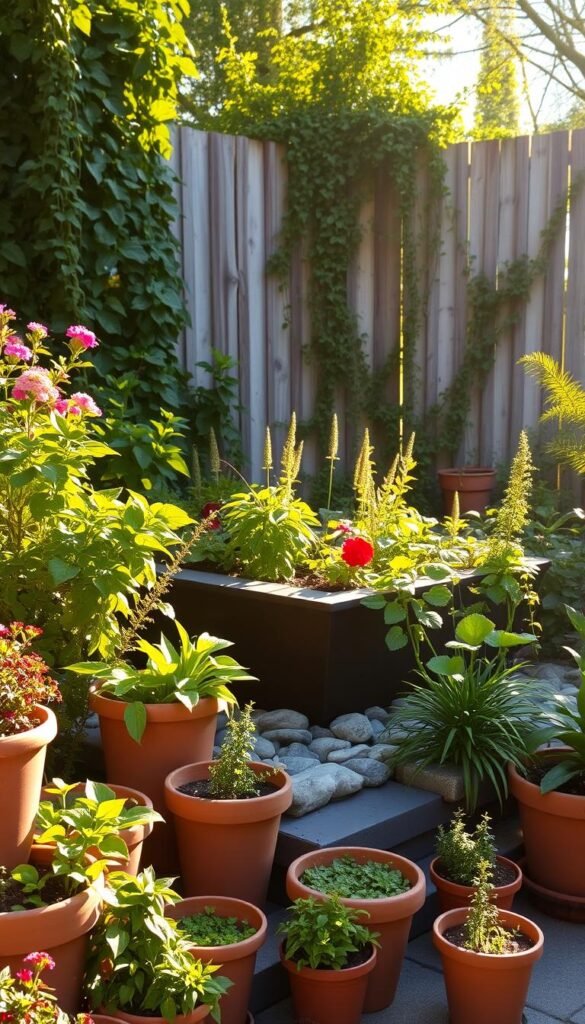
Struggling to make the most of your limited outdoor area? Ditch traditional ground planting for smarter solutions. Raised beds give you better soil control and drainage while avoiding the backache of tilling compacted earth.
One oversized planter makes a stronger statement than a dozen small pots. Try a 24-inch ceramic bowl bursting with colorful annuals – it becomes an instant focal point without visual clutter. Bonus: You’ll water less frequently than with multiple containers.
Group planters like a pro using the “thriller, filler, spiller” formula:
- Tall dracaena or ornamental grasses for height
- Mounding begonias or coleus as mid-level fillers
- Trailing lobelia or sweet potato vine softening edges
Raised beds work magic for renters and permanent gardeners alike. Their defined borders keep plants organized while allowing soil customization. Grow deep-rooted veggies in one box and shallow herbs in another – no cross-contamination.
Choose materials wisely. Fiberglass containers withstand frost cycles, while cedar planters resist rot. Avoid cheap plastic pots that crack in sunlight. “Your containers should outlast your plants,” advises urban gardener Lila Torres.
Remember: Bigger is better. A 30-gallon planter supports root growth better than six 5-gallon pots. Your plants thrive, and you spend less time rearranging tiny vessels.
Enhancing Ambiance with Outdoor Lighting
Imagine your evenings bathed in a soft glow that highlights your favorite garden features. Lighting transforms your outdoor space into a nighttime sanctuary, adding warmth and extending usable time in your personal retreat.
Solar-Powered and Eco-Friendly Options
Solar stake lights offer effortless installation – push them into soil or gravel paths for instant charm. String lights draped over pergolas create starry-canopy effects. Both options charge by day and shine by night, cutting energy costs.
Choose warm amber tones over harsh white beams. This gentle approach protects pollinators while creating cozy vibes. Lanterns with flickering LED candles add movement without fire risks.
Focus illumination where it matters most. Highlight a sculptural plant with directional spotlights. Use pathway markers to define walking space safely. Your entire area feels intentional, not overcrowded.
These simple additions prove you don’t need complex wiring for big impact. With strategic placement and eco-friendly choices, your evenings become as inviting as your daylight hours.

